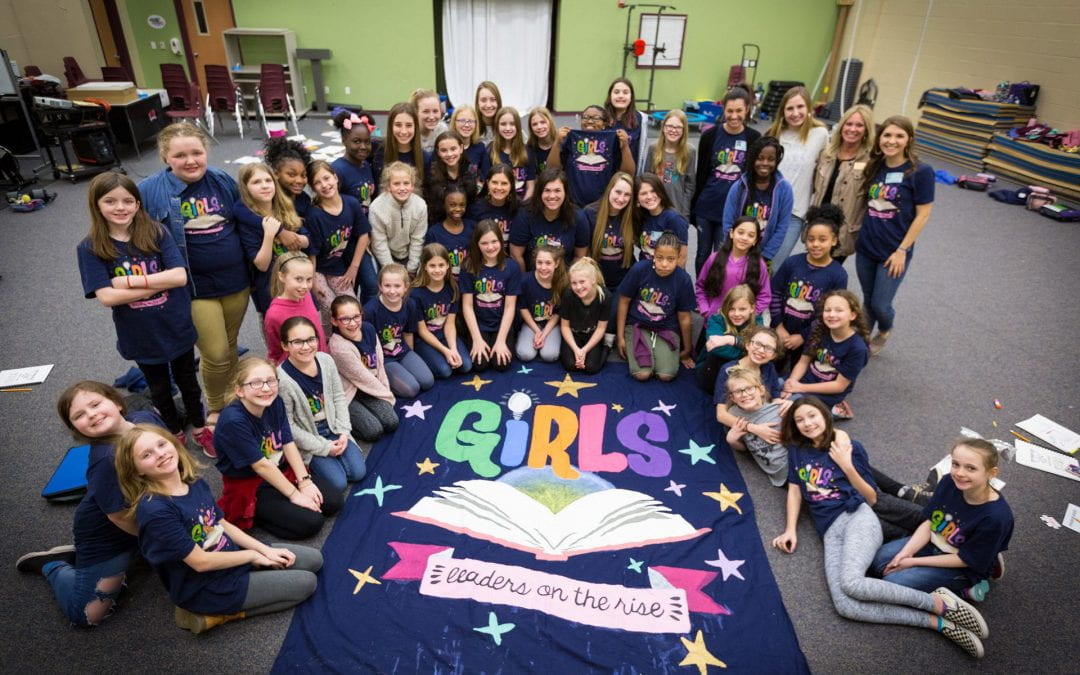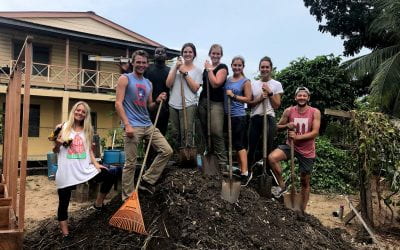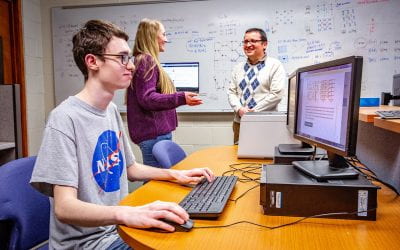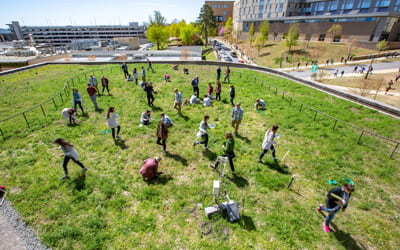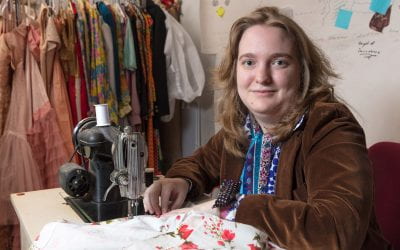Girl Power
By Kendall Curlee
Photos by Russell Cothren
Close to 40 fifth-grade girls are getting their ya-yas out as they try to maneuver an Oreo from forehead to open mouth – no hands allowed. The exercise invokes chaos, and more than a few cookies crushed underfoot, but the girls are quick to settle into a large circle anchored by Sophia Vincent, an honors education senior who easily commands the room.
Today is the last in a series of after-school sessions designed to build leadership skills in McNair Middle School girls, and the theme is “strength.” Vincent asks the students to share things they’re good at: “Math!” one girl volunteers, while others claim writing, gymnastics, and crafts.
“Are we all good at everything?” Vincent asks.
“No!” the girls chorus.
Vincent continues to hold their rapt attention as she reads Red: A Crayon’s Story, a simple fable about a red crayon that draws blue – and finds its niche by embracing its singularity.
It’s a simple concept, but an important one for these girls headed into the Sturm und Drang of adolescence.
“They’re trying to figure out their identity, figure out their place in their circle of friends, their school, their community,” Vincent said. “I wanted to focus on empowering girls at that age, and help them get a broader take on leadership, that it’s not just the one at the top of the social pyramid.”
The idea sprang from Girls Academy, a one-and-one-half-day empowerment program offered by Vincent’s sorority, Kappa Kappa Gamma. She led the outreach program for two years, and “I just saw such a need in that stage of development.”
For her honors thesis Vincent developed a five-week literacy-based mentoring program. She selected five aspects of leadership – growth mindset, integrity, resilience, love and loyalty, and strength – that together make up the acronym GIRLS. Each week the students would explore a theme as a large group, then break into small groups led by Kappa mentors. There, they completed activities in a journal that Vincent developed and crafted items to take home.
“The small groups are where they spent most of their time – one-and-a-half hours,” Vincent said. “McNair has over 700 students in the 5th and 6th grades, so these small groups helped them get to know other girls their age.” The students completed self-reflections – what they’d learned and how they would apply it in their own lives – before reuniting with the entire group to feast on a dinner of kid-friendly pizza, chicken or tacos.
It’s a fully packed three hours, and most would be in need of some serious nap time afterwards. But Vincent would go home to plan the next session, often retooling based on what she’d learned that day. In the first semester, for example, when working with the sixth-grade girls, “I discovered that they were big into theater, so I redid the lesson plan for the next week. A lot of girls came out of their shells after that.”
Faculty mentor Angela Elsass, a clinical associate professor in the K-6 Teacher Preparation Program, specializes in adolescent education. She reviewed lesson plans and attended each session but emphasized that the curriculum and materials were Vincent’s own. “Sophia developed the entire program herself, from the whole-group exercises to the workbooks, T-shirts and small mentor groups led by Kappas,” she said. “It’s a well-organized program, and the girls love her.”
More Field Notes
Model Garden to Boost Nutrition, Profits in Belize
A summer of beaches, tasty food, sunshine and a chance to serve. That’s the vision Zan Johnson, Bailey Carpenter, Natalie Zimmerman and Madison Ermert focused on as they tackled yet another pile of soil. Though the group anticipated unexpected adventures during the eight-week service-learning experience in Dangriga, Belize, they never dreamed of the sweat equity, sheer exhaustion and laughter that would accompany their journey.
Thin Tin
Two Honors College students have tackled – and solved – an important question about matter that sheds new light on the quantum world. Guided by mentor Salvador Barraza-Lopez, associate professor of physics, students Tyler Bishop and Erin Farmer have uncovered new information about tin oxide and have published their research in Physical Review Letters.
Rethinking Suburban Sprawl
David Sweere grew up in a classic American suburb in Maumelle, Arkansas, in a single-family home on a corner lot. He recalls a lot of lawn mowing and the fact that “you could see the Kroger grocery store from my house, but you couldn’t walk to it.” Fast forward through eight years of far-flung military service and six years of architecture school, and Sweere is ready to roll up his sleeves and redesign suburban sprawl.
Meet Rufus, Your Friendly Campus Green Roof
They’re strange bragging rights – but then again, it is a roof talking. And not just any roof – the U of A’s Hillside Auditorium green roof, which is exactly what it sounds like: a roof covered in about five inches of soil, atop which native plants have been growing since March 2013. The roof, affectionately dubbed “Rufus” by its student supervisors, has been tweeting measurement updates since early February 2019 via a Raspberry Pi microcomputer, thanks to senior Zack Wofford. Wofford was inspired by a tweeting tree he encountered while studying abroad in Ghent, Belgium.
On the Fashion of the Noldor in the First Age
Whether you’re a fan of Tolkien’s Middle Earth or have simply absorbed the cultural references it spawned (my precious…) you likely have a strong mental image of Tolkien’s characters. Galadriel, for example: Cate Blanchett, clad in white and silver, with flowing sleeves and Y-shaped fabric sash. Given the popularity of Peter Jackson’s film trilogy, that’s completely to be expected. But it’s also a problem, says Elkins native Grace Costello, who graduated in December 2018 with a degree in costume design from the Apparel Merchandising and Product Development program in the School of Human Environmental Sciences.
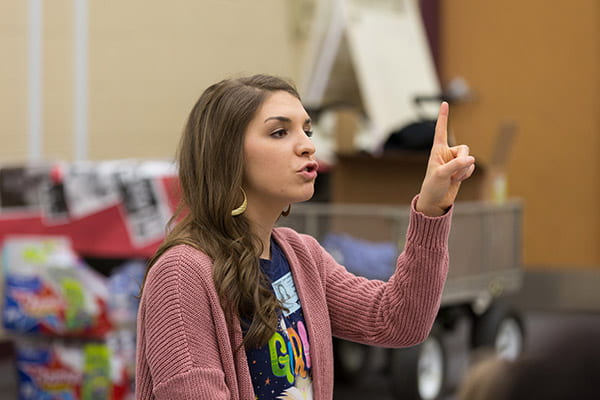

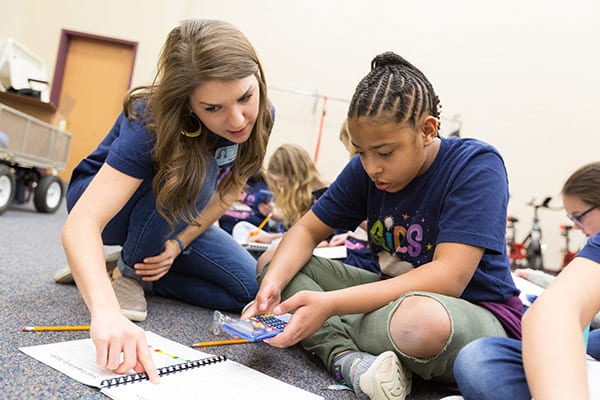
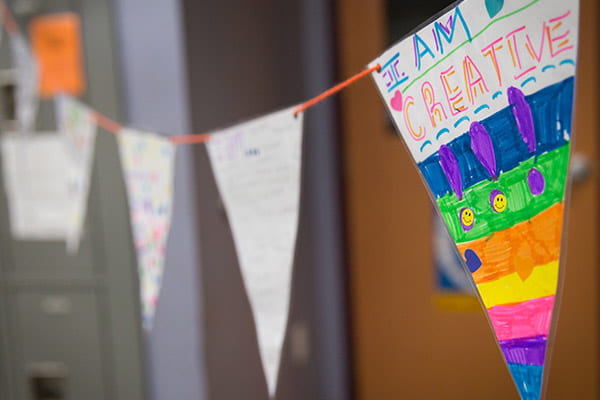
“I wanted to focus on empowering girls at that age, and help them get a broader take on leadership, that it’s not just the one at the top of the social pyramid.”

To assess impact, Vincent administered pre- and post-program surveys to the students and their parents, coded and analyzed the girls’ weekly self-reflections, and also considered observations and notes offered by her Kappa mentors. It’s a lot of number crunching: “I’m in the process of writing it up – basically the data does show that the program had a positive impact,” Vincent said. “The hard part is those moments when I see something in the girls that’s hard to measure.”
For example, at the first meeting the fifth-graders were timid and huddled in small groups with old friends. By the fifth week, “they walked in and they all sat down in a big circle, with no prompting from us. And when I asked, ‘how many of you made a new friend,’ every single hand shot up,” Vincent recalled with pride. “That tells you a lot, and that’s not something I can measure with statistics.”
Vincent’s research was supported by a SURF Grant.

